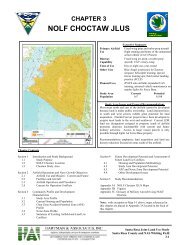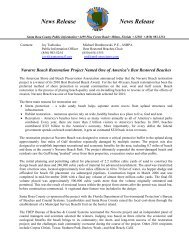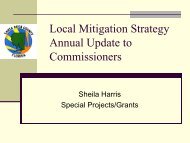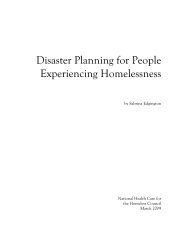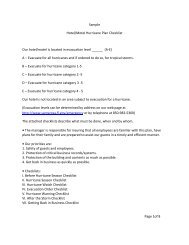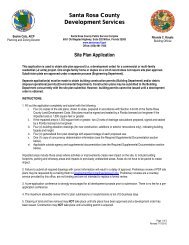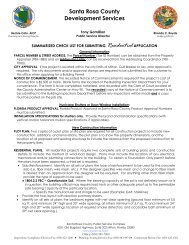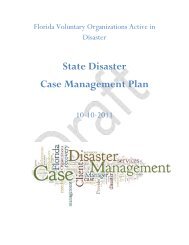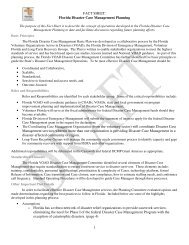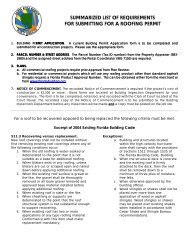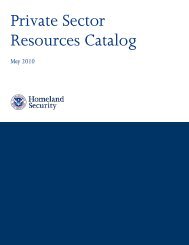Disaster - Santa Rosa County
Disaster - Santa Rosa County
Disaster - Santa Rosa County
Create successful ePaper yourself
Turn your PDF publications into a flip-book with our unique Google optimized e-Paper software.
Helping Children<br />
Cope with disasters<br />
Monitoring Your Family’s<br />
Exposure to the Media<br />
News coverage of the disaster can<br />
cause fear, confusion and anxiety<br />
in children, especially after a largescale<br />
disaster or terrorist incident, in<br />
which significant property damage<br />
and loss of life occurred. Repeatedly<br />
watching images of an event can<br />
cause younger children to believe<br />
the event is occurring continuously.<br />
Parents should be there for children<br />
to encourage communication and<br />
provide explanations when they are<br />
permitted to watch television or use<br />
the Internet if images or news about<br />
the disaster are being shown.<br />
42<br />
Children’s Pages<br />
<strong>Disaster</strong>s can leave children feeling frightened,<br />
confused, and insecure. It is important for<br />
parents and adults to be informed and ready to<br />
help if reactions to stress occur. Children may<br />
respond to disasters by demonstrating fear, sadness,<br />
or exhibiting behavioral problems. Children’s<br />
reactions are influenced by the behavior of adults.<br />
Adults should encourage children to share their<br />
thoughts and feelings about what is happening<br />
around them. Clarifying misunderstandings<br />
about risks and dangers by listening to children’s<br />
concerns and answering their questions is a<br />
good place to start. Maintain a sense of calm by<br />
validating children’s concerns and perceptions.<br />
Also engage in discussion of your plans for your<br />
family’s safety.<br />
Parents and adults can make disasters less<br />
traumatic for children by managing their own<br />
feelings and plans for coping. Children can<br />
detect others fears and sadness, especially during<br />
a disaster or an emergency. Parents are almost<br />
always the best source of support for children in<br />
disasters. Involving children in the preparation<br />
of a family disaster plan is one way to create a<br />
sense of control and encourage confidence before<br />
a disaster. After a disaster, including children in<br />
the family recovery plan will give them a sense<br />
of importance. Listen to what the child is saying.<br />
When a child asks questions about the incident,<br />
answer them as simply as possible avoiding any<br />
confusion. If a child has difficulty expressing<br />
feelings, allow the child to draw a picture or tell<br />
a story of what happened. Following a disaster,<br />
children are most afraid that the event will<br />
happen again, someone close to them will be<br />
killed or injured, or that they will be separated<br />
from their family and left alone.<br />
Actions Parents Can Take<br />
33<br />
Understand that your children will have a range of reactions to disasters.<br />
33<br />
Praise and recognize responsible behavior.<br />
33<br />
Encourage your children to talk about their feelings and concerns.<br />
33<br />
Calmly provide information about the disaster and plans for insuring<br />
their ongoing safety.<br />
33<br />
Involve your children in updating your family disaster plan and disaster<br />
supplies kit.<br />
33<br />
Involve your children by giving them specific chores to help them feel<br />
they are helping to restore family and community life.<br />
33<br />
Spend extra time with your children.<br />
Kids Activity Survival Kit<br />
You may have to leave your house during a disaster and may sleep somewhere<br />
else for a while. It’s smart to put together your own Kid’s Activity Survival<br />
Kit so you will have things to do and share with other kids. These can all be<br />
stored in a backpack or duffel bag. Just make sure you can carry it easily.<br />
FEMA suggests the following items for your Activity Survival Kit:<br />
<br />
A few of your favorite books<br />
<br />
Crayons, pencils or marking pens and plenty of paper<br />
<br />
Scissors and glue<br />
<br />
Two favorite toys such as a doll or action figure<br />
<br />
One or two board games<br />
<br />
A deck of cards<br />
<br />
A puzzle (One with lots of pieces is good - it takes a<br />
long time to do!)<br />
<br />
Small people figures and play vehicles that you<br />
can use to play out what is happening during your disaster - such as<br />
ambulance, fire truck, helicopter, dump truck, police car, small boats.<br />
<br />
Favorite stuffed animal or puppet<br />
<br />
Favorite blanket or pillow<br />
<br />
Pictures of the family and pet<br />
<br />
A “keep safe” box with a few treasures that make your child feel<br />
special.




